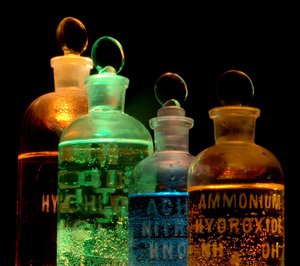The grams to grams formula can be used for one thing: finding the number of grams of a different substance by using the grams you have given. We know this formula will do that because stoichiometry uses the laws of conservation of mass, definite proportions, and multiple proportions. Basically this all means that element A as a reactant/product must be equal to element A as the opposite. It also means that elements in a reaction can not create, destroy or transmute mass with each other.
A few terms so you understand what I mean in some places:
“Given” – what we are given in the problem
“Required” – what we are looking for
“Mole ratio” – always the ratio of required/given
“Molar Mass” – the sum of the atomic masses of all of the elements in the substance/solution
The formula that we will be using here, and that works for all grams to grams equations is this:
Grams Required (X) = Grams Given x (1 mol/molar mass given) x mole ratio x (Molar mass required/1 mol).
This is saying that to find grams required, you take the given grams times one mol over the molar mass of the given substance times the mole ratio times the molar mass of the required substance divided by 1. The unit is put in under molar mass required and over molar mass given to simply show that the units will be changing. Here’s what you have with your units:
GRAMS/1 x MOLES/GRAMS x MOLES/MOLES x GRAMS/MOLES
In the first half, both of the grams cross out.
GRAMS/1 x MOLES/GRAMS x MOLES/MOLES x GRAMS/MOLES
And then, all of the moles cross out with each other, leaving you with grams.
GRAMS/1 x MOLES/GRAMS x MOLES/MOLES x GRAMS/MOLES
Let’s dive into some problems:
1. If you have 5 grams of Na, then how many grams will you have of NaCl in the following reaction.
2Na + Cl2 ———–> 2NaCl
Now, first of all, this equation is already given to you, and it is already balanced. So using the formula, we need to plug in the information that we have.
Grams Required (X) = 5g Na x (1 mol/22.99g Na) x (2/2) x (58.44g NaCl/1 mol)
We already had the grams given, the ratio of the two substances was 2:2, the molar mass of Na is 22.99g, and the molar mass of NaCl was 58.44g (Na = 22.99 plus Cl = 35.45). All that has to be done now is type it in the calculator and it’s finished! It should come out to be 12.7 grams of NaCl. Not so bad, huh? Let’s try one more.
2. Given 200g of AlCl3, find the number of grams produced of AgNO3.
3 AgNO3 + AlCl3 –> 3 AgCl + Al(NO3)3
This equation is already balanced, luckily. So let’s plug in our number and see what happens.
Grams Required (X) = 200g AlCl3 x (1 mol/133.33g AlCl3) x (3/3) x (169.91g AgNO3/1 mol)
We had 200g given, the ratio was 3:3 (remember, required over given!), the molar mass required was 169.91g (Ag = 107.9 plus N = 14.01 plus O3 = 48), and the molar mass given was 133.33g (Al = 26.98 plus Cl3 = 106.35). The answer that you should have gotten is 254.87g of AgNO3.



